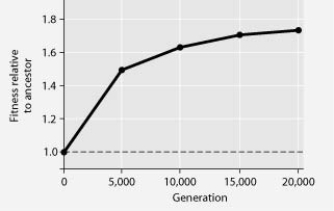Multiple Choice
The following question refers to the figure.
In this eight-year experiment, 12 populations of E. coli, each begun from a single cell, were grown in low-glucose conditions for 20,000 generations. Each culture was introduced to fresh growth medium every 24 hours. Occasionally, samples were removed from the populations, and their fitness in low-glucose conditions was tested against that of members sampled from the ancestral (common ancestor) E. coli population.
Compare the bacteria in the figure above in generation 1 and generation 20,000. The bacteria in generation 1 have a greater ________.
A) efficiency at exporting glucose from the cell to the environment
B) ability to survive on simple sugars, other than glucose
C) ability to synthesize glucose from amino acid precursors
D) reliance on glycolytic enzymes
Correct Answer:

Verified
Correct Answer:
Verified
Q1: Use the following information to answer the
Q3: Bacteria perform the following ecological roles. Which
Q17: Use the information in the following paragraph
Q26: Photoautotrophs use<br>A) light as an energy source
Q53: If a bacterium regenerates from an endospore
Q55: What is the goal of bioremediation?<br>A) to
Q61: Leaf-cutter ants harvest plant leaves and bring
Q69: Recently, a microbe that is able to
Q70: Which of the following describe all existing
Q72: Jams, jellies, preserves, honey, and other foods